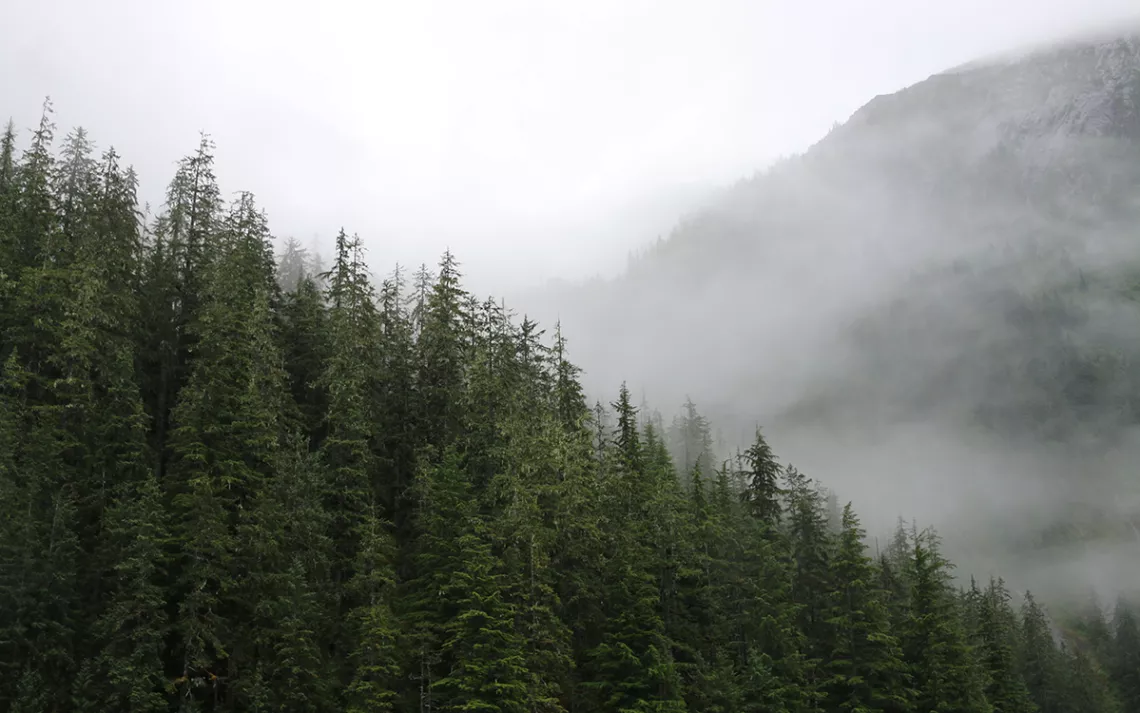New Protections for Ancient Trees
Biden administration halts old-growth logging in the Tongass National Forest

Photo by Eric Smith/iStock
Last week, many residents of Alaska’s Prince of Wales Island were braced for loss: Three thousand acres of old-growth temperate rainforest on the remote island were slated to be clearcut. Although the US Forest Service said in 2010 that it intended to phase out old-growth logging in the Tongass National Forest—a 16-million-square-mile labyrinth of mountains, islands, and fjords that covers much of Southeast Alaska—the transition has been slow, especially on Prince of Wales. Known as Taan to Tlingit and Haida people, the island has long been an ecological sacrifice zone: While the Tongass as a whole has retained 88 percent of its old-growth forest, one study estimates that only 6 percent of productive ancient forest on the northern half of Prince of Wales remains unlogged.
The island’s 5,500 residents expected that percentage to shrink even further as the Forest Service prepared to sell thousands of enormous cedar, hemlock, and spruce trees, likely to Viking Lumber, the last large lumber company still operating in the Tongass.
Then, on July 15, President Joe Biden's administration announced it would immediately halt old-growth timber sales in the Tongass, including on Prince of Wales.
“This is a sea-change moment for Southeast Alaska," says Mary Catharine Martin, communications director for the Alaska environmental nonprofit SalmonState. “Old-growth forest keeps salmon runs strong, stores carbon, and supports our communities.” A recent study found that the Tongass stores 44 percent of all carbon in US national forests, so keeping the Tongass’s big trees standing means keeping that carbon out of the atmosphere.
In addition to ending industrial old-growth logging in the Tongass—the last national forest in America where such logging was still permitted—the Biden administration said it will move to reinstate the Roadless Rule, which protects roadless portions of the Tongass from new development and logging. The rule was created by Bill Clinton, rolled back in the Tongass by George W. Bush, reinstated by Barack Obama, and repealed again in 2020 by Donald Trump.
While it’s tempting to see Biden’s announcement as merely the latest swing in a high-stakes game of ping-pong, this may well be the end of the Tongass timber wars—and of old-growth logging in America’s national forests. That’s because in spite of occasional political efforts to revive it, Southeast Alaska's timber industry may be too weak to survive to another presidential administration. Over the past two decades, a combination of environmental lawsuits and market forces have brought the industry to its knees.
Logging in Southeast Alaska has never made economic sense: The cost of cutting trees on rugged, remote islands far from international supply chains outweighs the market value of those trees. To support local economies, the federal government subsidizes logging, meaning taxpayers pay tens of millions of dollars each year to cut Alaska’s ancient forests.
As those economic realities met with shifting public opinion on the morality of old-growth logging, timber sales dwindled and jobs shifted toward fishing and tourism. Seven of the region’s eight big mills have closed, and timber now represents just 1 percent of the regional workforce. Sealaska, an Alaska Native corporation that historically logged its tribally held parcels of forest in Southeast Alaska, announced in 2018 that it made more economic sense to keep a portion of the trees standing and sell the carbon credits to California.
Despite these changes, the Forest Service continued to disproportionally use its influence to prop up the dying timber industry. As of 2015, the agency still spent 37 percent of its budget, or $22 million, fanning the dying flames of the timber industry.
Now that the Forest Service is ending old-growth logging full stop, it’s unclear whether Viking Lumber will be able to stay in business long enough for a new president to try to breathe life back into the dying timber industry. (The company did not return a phone call asking for comment.) And without Viking Lumber, industrial-scale clearcutting of old-growth trees is unlikely to return to the Tongass. As Martin of SalmonState put it, “Southeast Alaska’s economy has already moved on.”
While climate scientists, salmon fishermen, and environmental and Indigenous activists celebrate this news, it’s nonetheless a blow for communities still reeling from the decline of logging jobs. As part of its announcement, the Forest Service pledged to support these communities by investing “approximately $25 million in financial and technical resources in sustainable opportunities for economic growth and community well-being.” It will also offer “micro sales” of old-growth trees to help keep small local mills afloat and allow Indigenous people to selectively harvest trees for traditional uses, such as building totem poles and canoes.
Elsa Sebastian, a fisherman, filmmaker, and activist who grew up on Prince of Wales, says this feels like the start of a new era for the Tongass. “I’ve been advocating for the Tongass for my entire adult life, and when I was a kid I remember my parents and neighbors doing the same,” she says. “And I can say that this feels like the first time that we've been talking about the future.… It’s so relieving to know that we will no longer be on the defensive.”
 The Magazine of The Sierra Club
The Magazine of The Sierra Club



